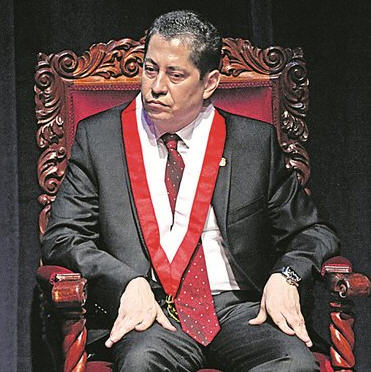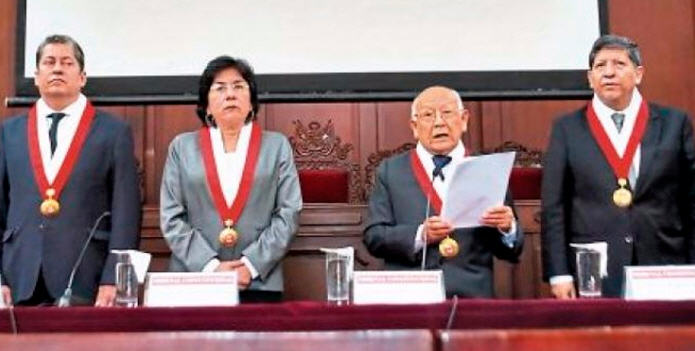 While lawmakers try to convince their colleagues to vote on Thursday either for or against the ousting of President Kuczynski, the Constitutional Court today faced its own internal struggle to oust one of its seven magistrates.
While lawmakers try to convince their colleagues to vote on Thursday either for or against the ousting of President Kuczynski, the Constitutional Court today faced its own internal struggle to oust one of its seven magistrates.
The motion to fire Justice Eloy Espinosa-Saldaña fell short of one vote. On a panel of seven, four votes are required for a decision.
An initial attempt by Congress to penalize four justices who corrected a vote count from a 1996 ruling (see El Fronton, below), was slapped down last month by the Inter-American Court of Human Rights, IACHR, as unconstitutional. The move was to suspend three of the justices and fire the third, Espinosa-Saldaña.
The opposition majority in Congress were not happy with human rights court’s conclusion, and while they have been seeking other options, a member of the Constitutional Court itself put forth the motion to oust Espinosa-Saldaña.
The grounds presented by Justice Jose Luis Sardón are that Espinosa-Saldaña lied in his resumé three years ago, by including the title of doctor despite not completing a doctoral degree.
Political analyst Rosa Maria Palacios sees the charge as just an excuse to get rid of a vote that most probably will not be favorable to Fujimorista interests — in Peru, the title of “doctor” is not only used by doctoral graduates and physicians but by all attorneys at law and often to address anyone of note, regardless of their graduate status. Ironically, the president of the Constitutional Court, Ernesto Blume —who voted to oust Espinosa-Saldaña— is addressed as doctor but does not have a PhD.
Former state prosecutor Avelino Guillen said the issue is inexplicable because three years ago, in 2014, Espinosa-Saldaña corrected his resumé, Congress accepted his correction and subsequently elected him by a majority to the Court. “It’s clear this is a reprisal” for his opinions on the court, Guillen told La Republica daily.

“What was behind this is a political move to try to control a majority in the Court,” warned Walter Alban, head of the independent ethics institution Proetica and a former People’s Ombudsman.
In December 2017, the Fujimorista party Fuerza Popular voted to remove Eloy Espinosa-Saldaña form the Court and suspend the other three justices.
Why? The reprisal is undoubtedly because of the El Fronton case, but there are still several cases that the Court is set to rule on that affect political issues, including an appeal against a law approved by Congress (but not enacted) to prohibit lawmakers from leaving their party to become independent or cross to another bench, or to form independent parties; the appeal by President Humala against his amd jos wofe’s preventive imprisonment; and Keiko Fujimori’s appeal last year to declare null and void her father’s conviction of crimes against humanity — although Alberto Fujimori is now free, a repeal would still guarantee he would never return to prison on that charge.
Espinosa-Saldaña remains on the panel of judges, but he has been removed from the position of vice-president. His successor is Manuel Miranda, the oldest member on the panel and one of the four judges who Congress sought to penalize.
The case of El Fronton
In 1986, at least 113 prisoners died in a mutiny on the island of El Fronton, a violent battle that was quelled by the Navy. When the Constitutional Court saw the case in 2013, a majority vote ruled that the charges of murder of prisoners convicted of terrorism had prescribed. However, one of the judges ruled that it was not the Constitutional Court’s responsibility to decide because it was a crime against humanity and should be seen by the ordinary justice system. Justices Eloy Espinosa-Saldaña, Carlos Ramos, Marianella Ledesma and Manuel Miranda therefore ruled that his vote had been mistakenly counted in favor of the prescription, and so tipped the decision against the plaintiffs. The trial of 35 navy officers and subalterns began in September 2017, and the prosecutor has called for sentences of 25 to 30 years in prison. Former President Alan Garcia, who gave orders to quell the riot and simultaneous riots in three other Lima prisons, is to testify at the trial.





